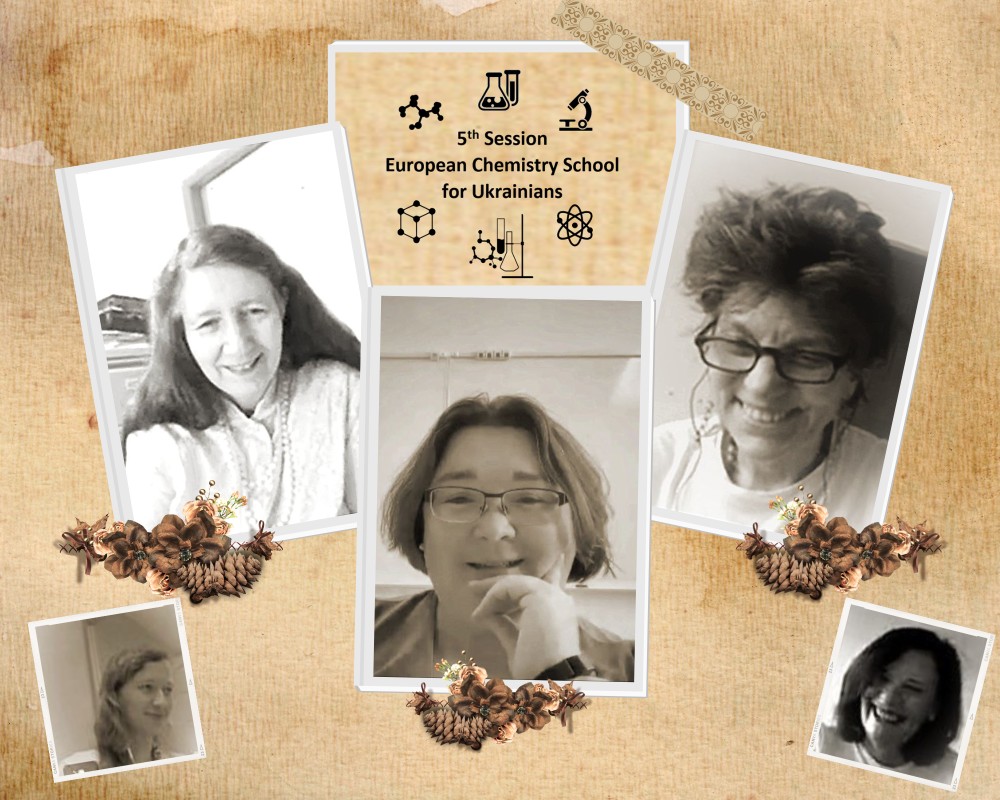European Chemistry School for Ukrainians
5th Session June 29th 2023
Prof. Dr. Anne-Marie Caminade, the Deputy Director of the Laboratory of Coordination Chemistry in Toulouse, Prof. Dr. Silvia Bordiga of the University of Turin, and Dr. Evelyn Ploetz of Ludwig Maximilian University in Munich addressed the fifth and penultimate session of the European Chemistry School for Ukrainians.
Prof. Caminade presented her group’s research on the synthesis and applications of phosphorous dendrimers. Just as dendrimers branch out in many different directions, Prof. Caminade’s research branches into many distinct fields, with applications in catalysis, materials science, and biology. The Caminade research team has used dendrimers to catalyze pyrazole coupling, cycloadditions, and Friedel-Crafts acylation (among other reactions). Her team has not only created very effective catalysts (they have noted 100% recovery after multiple cycles in some systems), but has been able to explain trends in dendrimer efficacy, relating the size of the dendrimer and the efficiency of the catalyst. Her dendrimers can also be used to make new materials with incredible properties – color-changing hydrogels, bilayer nanotubes, pollutant-capturing clay amendments, and DNA sensing chips that are already being used to detect infectious bacteria in 15 hospitals – and this is just one of the many biomedical applications of dendrimers her group has studied. Prof. Caminade’s team has also used dendrimers to combat cancer, tuberculosis, multiple types of inflammation, multiple sclerosis, and several other diseases. With so many applications, it is no surprise that Prof. Caminade holds a few dozen patents.
Caminade says that many of her ideas come from conversations with others; she is frequently approached by aspiring collaborators. At the start of her career, Caminade says she “did not imagine all the properties they [dendrimers] would have.” She recommended this adaptable attitude to the young researchers in her audience, saying “Maybe you will not do exactly what you want to do, but try to be happy with what to do,” and went on to explain that she originally planned to be a physicist but transferred to the study of chemistry “where I had very low marks.” Prof. Caminade has since been honored with many prestigious awards from the French Chemical Society and is globally recognized as a pioneering researcher; it would seem that her “low marks” had very little impact on her esteemed career. To this day, Caminade says that she regards herself as “a researcher, not a chemist” – her expansive list of research interests reflects her commitment to doing research without respect to boundaries between different fields. Looking toward the future, Prof. Caminade said she was most excited to see her dendrimers come into practical use, expressing hope that one of her anticancer dendrimers would soon enter clinical trials and would someday be used to treat patients.
Prof. Dr. Silvia Bordiga of the University of Turin introduced the audience to her work on zeolites and metal-organic frameworks (MOFs). Zeolites and MOFs, both porous solids with high internal surface areas and specialized topological and structural features, are very similar compounds; zeolites must meet stricter specifications that MOFs (i.e., zeolites are all tetrahedral frameworks with linking oxygen bridges while MOFs can have any number of different connectivities and employ a diverse array of organic molecules). Prof. Bordiga’s research focuses on the applying these unique materials as catalysts. Specifically, the Bordiga team is motivated by the challenge of creating a green energy economy: they are working to develop a catalyst that can convert the notorious greenhouse gas carbon dioxide and hydrogen into methanol, a very useful compound that Bordiga described as “the platform for all molecules”.
Prof. Bordiga promoted the principles of standardizing research and communication around the globe. She lamented that MOF development is slowed by the haphazard array of unrelated and scientifically meaningless names given to new structures and the skepticism she (and her peers) must use to assess new MOFs, which are not verified by any evaluating authority. She compared this to the zeolite verification council, which meticulously checks each new structure. Her own research style, thoughtful and organized, exemplifies the efficiency she hopes will be imitated by rising researchers.
Dr. Evelyn Ploetz wrapped up the seminar with a discussion on the multimodal imaging processes she and her team have developed to study molecular processes. Dr. Ploetz’s goal is to perfect a reliable and versatile optical tool that can perform many different functions (light microscopy, fluorescence imaging, etc.) and meet the requirements of the many different materials she studies, which necessitate systems that are biocompatible, non-invasive, label free, and have high space/time resolution. Dr. Ploetz has already developed tools to study a number of different systems. For example, Dr. Plotez was able to show how a collaborator’s MOF-based nanoparticle drug delivery system enters living cells and explain exactly how changes in cellular pH alter the release profiles of cargo. The Ploetz team also developed MOSAIC, an amazingly versatile imaging tool that has been used to study the uptake of guest molecules in MOFs as part of a particularly exciting project exploring the potential of these materials in water harvesting applications.
Dr. Ploetz’s advice for young researchers was pragmatic – aim to work in labs that are well funded and have the resources to support the unencumbered ideas and fanaticisms characteristic of early career scientists. She paraphrased the words of Sir. Frasier Stoddart: always have 5,000 ideas, write them down, and then focus on the one idea with the greatest potential outcomes. Researchers, she explained, are already limited by time – it is best to remove all other practical barriers and give new ideas space to grow.
Written by Madeline Walden
Photo Collage by Orysia Zaremba



